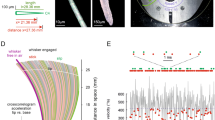Summary
We have used microneurographic techniques in human subjects to record mechanoreceptive afferent responses to standard Braille characters scanned across the finger pads. Responses from all four mechanoreceptor classes (FA I, FA II, SA I and SA II) have been reconstructed to form two-dimensional Spatial Event Plots (raster plots) of the Braille alphabet. Both the SA I and FA I responses resolve the dot patterns of Braille characters with sufficient fidelity that the representations of the individual characters can be recognized visually. Responses from SA II and FA II afferents do not resolve the Braille characters. We believe that the Spatial Event Plots derived from SA I and FA I responses closely approximate the images that are transmitted within a human nerve during Braille reading.
Similar content being viewed by others
References
Bledsoe W (1972) Braille: a success story. In: Evaluation of sensory aids for the visually handicapped. Natl Acad Sci, Washington DC
Collins CC (1985) On mobility aids for the blind. In: Warren DH, Strelow ER (eds) Electronic spatial sensing for the blind. Matinus Nijhoff, Dordrecht, The Netherlands, pp 35–64
Craig JC (1979) A confusion matrix for tactually presented letters. Percept Psychophys 26:409–411
Day RH, Dickinson RG (1979) Learning to identify braille numerals with active and passive touch. Res Note, Monash University, Melbourne
Grunwald AP (1965) A braille-reading machine. Science 154:144–146
Johansson RS (1978) Tactile sensibility in the human hand: receptive field characteristics of mechanoreceptive units in the glabrous skin area. J Physiol (Lond) 281:101–123
Johansson RS, Vallbo AB (1979) Tactile sensibility in the human hand: relative and absolute densities of four types of mechanoreceptive units in glabrous skin. J Physiol (Lond) 286:283–300
Johansson RS, Vallbo AB (1980) Spatial properties of the population of mechanoreceptive units in the glabrous skin of the human hand. Brain Res 184:353–366
Johansson RS, Vallbo AB (1983) Tactile sensory coding in the glabrous skin of the human hand. Trends Neurosci 6:27–32
Johnson KO, Lamb GD (1981) Neural mechanisms of spatial tactile discrimination: neural patterns evoked by braille-like dot patterns in the monkey. J Physiol (Lond) 310:117–144
Johnson KO, Phillips JR (1981) Tactile spatial resolution. I. Two-point discrimination, gap detection, grating resolution and letter recognition. J Neurophysiol 46:1177–1191
Johnson KO, Phillips JR (1988) A rotating drum stimulator for scanning embossed patterns and textures across the skin. J Neurosci Meth 22:221–231
Knibestol M, Vallbo AB (1970) Single unit analysis of mechanoreceptor activity from the human glabrous skin. Acta Physiol Scand 80:178–195
Loomis JM (1981) On the tangibility of letters and braille. Percept Psychophys 29:37–46
Loomis JM (1985) Tactile recognition of raised characters: a parametric study. Bull Psychonom Soc 23:18–20
Meyers E, Ethington D, Ashcroft S (1958) Readability of braille as a function of three spacing variables. J Appl Psychol 42:163–165
Nolan CY, Kederis CJ (1969) Perceptual factors in braille word recognition. American Foundation for the Blind, Res Series no. 20, New York
Ochoa J, Torebjork E (1983) Sensations evoked by intraneural microstimulation of single mechanoreceptor units innervating the human hand. J Physiol (Lond) 342:633–654
Phillips JR, Johnson KO, Hsiao SS (1988) Spatial pattern representation and transformation in monkey somatosensory cortex. Proc Natl Acad Sci USA 85:1317–1321
Reed CM, Durlach NI, Braida LD, Schultz MC (1982) Analytic study of the Tadoma method: identification of consonants and vowels by an experienced Tadoma user. J Speech Hear Res 25:108–116
Santoro JA, Palmer CI, Gardener EP (1987) Responses of mechanoreceptors to stripe patterns on the Optacon. Soc Neurosci Abstr 13:472
Sherrick C (1984) Basic and applied research on tactile aids for deaf people: progress and prospects. J Acoust Soc Am 75:1325–1342
Vallbo AB, Hagbath KE (1968) Activity from skin mechanoreceptors recorded percutaneously in awake human subjects. Exp Neurol 21:270–289
Vallbo AB, Johansson RS (1984) Properties of cutaneous mechanoreceptors in the human hand related to touch sensation. Hum Neurobiol 3:3–14
Author information
Authors and Affiliations
Rights and permissions
About this article
Cite this article
Phillips, J.R., Johansson, R.S. & Johnson, K.O. Representation of braille characters in human nerve fibres. Exp Brain Res 81, 589–592 (1990). https://doi.org/10.1007/BF02423508
Received:
Accepted:
Issue Date:
DOI: https://doi.org/10.1007/BF02423508




